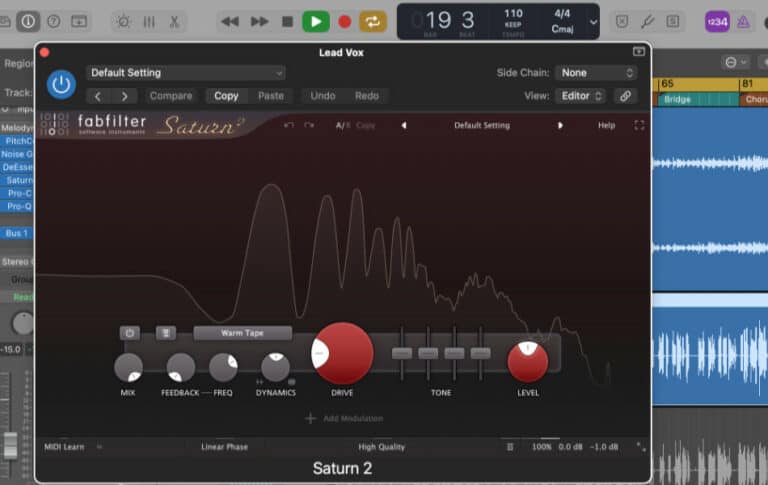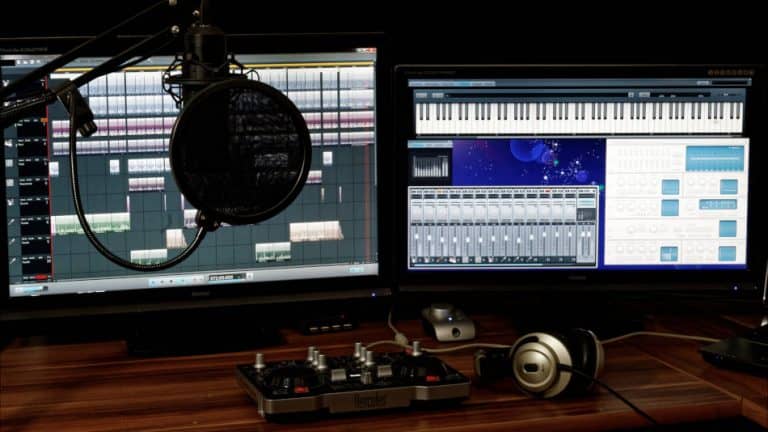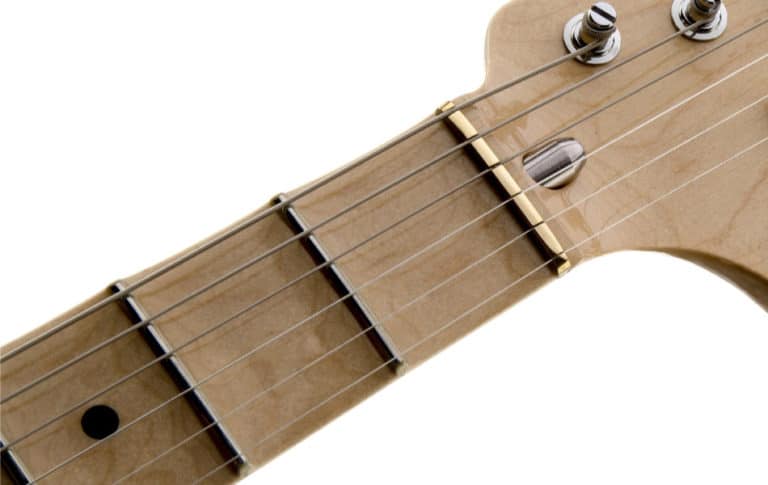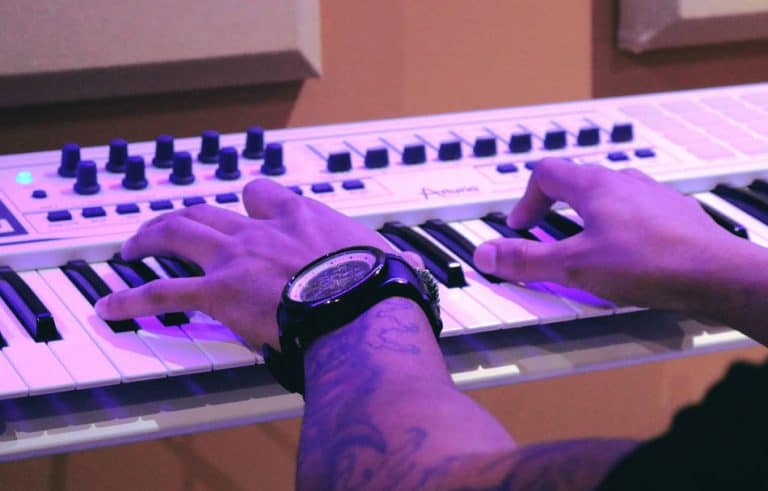Should You Store Your Sample Libraries on an External Hard Drive?
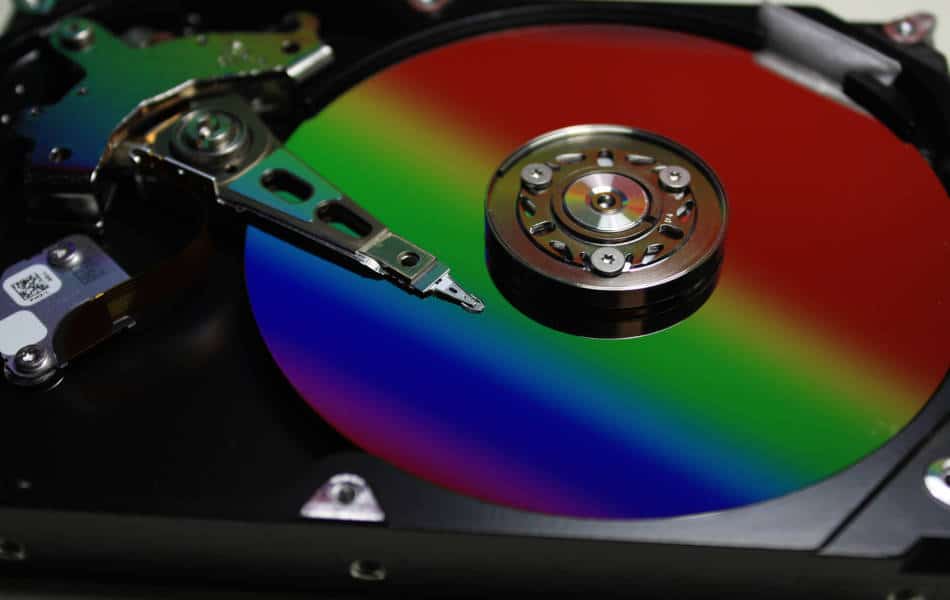
Sample libraries and other audio files can fill your computer’s hard drive up faster than almost anything.
As soon as you start to accumulate sample libraries and collections of other audio files the built-in hard drive that you thought would be big enough can quickly run out of space.
The obvious answer to this problem is to use an external hard drive. You probably already use an external hard drive to back up your work, but should you keep your sample libraries on an external drive to access while you are working?
Should you store your sample libraries and other audio files on an external hard drive? Accessing your sample libraries from an external hard drive can help your computer to use resources more efficiently and lets you organize your work better. HDD and SSD are the two main options. SSD is more expensive but works more more efficiently. SSD prices are coming down so this will be an even better option going forward.
Why Would You Want to Keep Your Samples on a Separate Hard Drive?
The most obvious reason for keeping your samples or libraries on an external drive is to save space on your computer’s internal hard drive.
Probably the only thing that will fill your hard drive faster than audio files is video files. Individual audio files tend to be much smaller than individual video files, but if you look at the size of some of the sample libraries available you will see that they can be pretty huge.
For example, Native Instruments’ Kontakt is one of the most popular software samplers, used in the production of many types of music. The Kontakt instruments are collections of individual audio samples, and some include hundreds of audio files.
Kontakt comes with several sample libraries, and the one that includes the widest range of different instruments is called the Kontakt Factory Library.
This library will take up over 23GB of space on your hard drive. That’s quite a lot, but there’s also a catch.
Installing Sample Libraries Needs More Space Than You Might Think
When I bought Kontakt I wasn’t able to download the Factory Library because the Native Access application that manages the installation said there wasn’t enough space.
The MacBook I was using had a 500GB hard drive, and the disk management app said I had nearly 90GB free, so you would think that would be plenty.
It turns out that you need space for the application to be downloaded plus enough space for the download package to be unpacked and the library installed. I was told that this requires disk space equivalent to twice the size of the library, but in practice it seems to need much more.
I was going to download the library to an external hard drive I use for backups and then install it on my computer’s hard drive. But then I decided to think about storing these sample libraries on an external drive and running them from there.
I bought a fairly small external hard drive to store the Kontakt sample libraries and I’m so glad I did. This one purchase (that I was trying to avoid) has made a huge difference.
Accessing Audio Files – Not Just for Backing up Your Work
We’re not talking here about storing your sample libraries on an external drive then copying them onto your computer’s internal drive when you want to use them. This is about keeping your sample libraries on an external hard drive and running the sample libraries directly from this drive.
In this set-up you have your software sampler instrument, Kontakt or HALion, for example, installed on your computer’s internal hard drive. You keep all of your sample libraries on the external hard drive and the software sampler calls them up from the external drive as it needs them.
Advantages of Using an External Drive
Backing up Your Sample Libraries
Commercial sample libraries are usually supplied with a licence number that you can use to download the libraries again if you ever need to.
With free samples and libraries, and those without a licence number, there can be a limit to the number of times you can download them. The reasons may include avoiding pirating, but mostly it’s because these libraries are usually pretty big and it costs the developers money for hosting bandwidth every time they are downloaded.
For this reason you might not need to keep a backup of commercial sample libraries, but it would be a good idea to keep a backup of free and other non-commercial libraries just in case you have a computer failure or accidentally delete the files.
However, as stated earlier, we’re not really talking about using an external hard drive for backups here, but to run the sample libraries by streaming them in real time.
Using an External Hard Drive Can Improve Computer Performance
Much of the advice available says that using an external hard drive to stream your audio samples can actually improve the performance of the computer running your DAW (digital audio workstation) software.
Some of the information on this is quite technical, and there does seem to be some disagreement, but here is what informed people seem to be saying.
The DAW software plus virtual instruments and effects are running from the computer’s internal hard drive. So the computer is running its operating system, the DAW software, and any other processes from the same internal disk.
Each time the computer’s internal memory and CPU (central processing unit) requests more data it is coming in from that one internal disk. Frequent requests for audio information stored on the same disk can slow access to the audio files and other computer resources since it’s all coming down the same channel.
Accessing the audio information from an external hard drive brings the large audio files in through a separate channel, which helps to avoid the potential “bottle-neck” problems in the scenario above.
Split Your Sample Libraries on Separate Disks
I’ve also seen it recommended that sample libraries are split across multiple external hard drives.
The idea is that if each drive is connected to a separate port on your computer it will reduce the potential for “throttling” the flow of streaming audio file coming. This is apparently because data from each disk is coming into the computer’s working memory through a separate channel.
The use of multiple drives also helps to reduce delays caused by the disk trying to read and write data at the same time.
I had difficulty accepting this idea, since my view had always been that if all the data is in one central place (internal hard drive) then it could be accessed more efficiently when it’s needed.
I’m learning this is just one of the ways that separating aspects of your music production process can help to use computer resources more efficiently.
For example, coming back to Kontakt, if you have separate instances of the instrument on separate tracks it uses computer resources more efficiently than if you run the same number of instruments inside one instance of Kontakt.
Using an External Hard Drive Lets You Organize Your Samples Better
Trying to keep all your sample libraries on the computer’s internal disk can make file management very difficult.
When I was trying to manage everything on the computer’s internal disk I was constantly worried about filling up the disk. To avoid this I was storing sample libraries on USB flash drives and external hard drives and only copying them onto the computer’s drive as I needed them.
As a result I frequently lost track of where everything was and I ended up with the number of audio files on my computer disk building up, which resulted in a loss of free space.
Now, I try to keep libraries of samples and audio files on an external hard drive.
Software sampler libraries are streamed from the hard drive, so they are not copied to the computer’s disk.
Audio files that are imported into projects have a copy stored in the project file. Since it’s only the audio files used in the project that are copied there aren’t really any issues with this taking up a lot of space on the computer’s disk.
Disadvantages of Using an External Drive
Loss of Convenience
Probably the main disadvantage of keeping your sample libraries on an external hard drive is inconvenience.
If you use your laptop computer for music production it can be real pain having to connect an external hard drive before you can start producing music.
The level of inconvenience probably depends on how you work. If you are mostly using virtual synthesizers then you may have no need to connect your external drive. You would only need to do this if you wanted to use a software sampler like Kontakt or HALion, or audition a lot of samples for use in a project.
External Drives Occupy Additional USB Ports
There is a limit to the number of USB (or other external ports) that your computer has available.
If you have an external MIDI keyboard, then one has gone already. An audio interface will take up another one. If you’re using Cubase then another one has been already been used by the USB licenser.
My MacBook has two USB ports, so this would make things quite difficult. It also has two Thunderbolt ports (it’s nearly six years old), but hardware that uses Thunderbolt ports tend to be expensive and you would need to buy adaptors to use standard USB equipment.
You could use a USB hub, but that would probably introduce more inconvenience and connecting more than one external hard drive this would would introduce another data “bottle-neck” where the USB ports on the hub converge to connect to the computer.
But This Tells You Your Studio Set up Is Developing
You should take some encouragement from this inconvenience though. Starting to need these additional connections to the computer running your DAW software tells you that your studio set up is developing, which means you as a music producer are developing too.
HDD vs SDD – Which Type of External Drive Is Best?
HDD is short for hard disk drive and SSD is short for solid state drive. As the name suggests, HDD has a disk inside that spins as you read and write data from it. SSD has no moving parts and data storage is done in memory chips.
The biggest advantage of the HDD option is that you get a lot of storage space for your money. At the time of writing you can get a 1TB (terabyte – 1,000 GB) HDD for less than $50.
The disadvantage of HDD is that data access can be quite slow and the drives can be noisy.
SSD units have fast data access times, since data retrieval involves solid state memory rather than a spinning disk. Also, the absence of moving parts means that they don’t make any noise.
I chose to buy a SanDisk Extreme Portable SSD drive, which I bought from Amazon.com (you can see it using the link).
Something that surprised me when using an external SSD to access sample libraries is how they get. It just shows how much data transfer is going on and made me think about how hard an HDD would have to work to transfer this amount of data.
What Type of Connection Port Do You Need?
The type of USB port on your computer is also important for how quickly data can can be transferred into your computer from the external drive.
Apparently, USB2 connections are too slow for sample libraries to be accessed from an external drive, whether that’s an HDD or an SSD.
Most computers now have USB3 or even the faster USBC ports now, so data transfer shouldn’t be limited by this.
Can I Use a USB Stick to Store My Sample Libraries?
When shopping for an external drive you might notice that USB flash drives (also know as USB sticks, etc) offer quite a lot of capacity for a fairly low price.
This isn’t really a viable option to used for accessing sample library files in real time. They data access is too slow to be practical in most situations.
These drives are a great option for storing audio files to copy into projects, backing up your work, or transporting projects from one computer to another. However, they aren’t good for connecting your software sample libraries to your software sampler.
Hard Drive File Organization for Music Production
Once you have chosen the right external hard drive for your needs you just need to organize the sample libraries and other audio files on the drive.
There are a number of options for organizing your files, but if you choose one and stick to it consistently you won’t get confused later.
Choose a naming system that makes sense for you so that you can find what you are looking for easily. I have made the mistake of not taking the time to name and organize everything properly in the past, and I wasted a lot of time and creative ideas while searching for things
Sample Libraries Are Getting Bigger
I had always liked the convenience of running everything from the computer’s internal hard drive (and I still do) but you seem to need much more space for everything as time goes on.
When I got the original Steinberg HALion sampler, version 1, back in the early noughties it came with some sample CDs that took up just under 500MB of computer disk space. That seemed enormous at the time, but it’s pretty small by today’s standards.
My recommendation to start off would be an SSD that provides you with enough space for your immediate needs and enough additional space for your needs going forward in the very near future.


